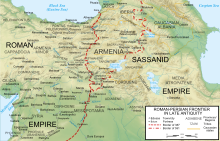Citharizum

Citharizum (from Greek: Κιθαριξων) was a town and fortress on the south arm of the Euphrates[1] in the Roman province of Armenia III.
According to Procopius of Caesarea, the city was located in the Asthianene region.[2] The fortress was separated from Theodosiopolis (present-day Armenia) by a journey of four days.[3] Balabitene, a region between Masius and Anti-Taurus, north of Commagene and Mesopotamia, is also discussed as a possible location. Citharizum is often associated with the modern village of Keteriz.[4][5][6]
Although only a small town, it was an important point of defence for the Byzantine Empire against the Persians. Justinian built a castle there, in which he stationed a garrison under the command of a duke.[4][7][8] In 613, it was taken by Ashot, a general of the Persian king, Chosroes II.[4]
Bishopric[]
The only diocesan bishop of the see whose name is recorded is Marcian, who attended the Trullan Council of 692.[4][7][9][10]
No longer a residential bishopric, Citharizum is today listed by the Catholic Church as a titular see.[11]
External links[]
- A map of Sassanid Persia showing Kitharizon, situated south of Theodosiopolis, north of Amida, east of Arsamosata and west of Manazkert: Map
References[]
- ^ "The Classical Gazetteer". Archived from the original on 2007-03-05. Retrieved 2014-09-07.
- ^ Procopius, Buildings Book III, University of Chicago
- ^ Procopius, History of the Wars Book II, Chapter XXIII, en.wikisource.org
- ^ a b c d Sophrone Pétridès, "Citharizum" in Catholic Encyclopedia (New York 1908)
- ^ Titular Episcopal See of Citharizum, gcatholic.org
- ^ Others associate ancient Kitharizon with the present-day location Yeni Köy. Map 89 Armenia, princeton.edu
- ^ a b Raymond Janin, v. Citharizum, in Dictionnaire d'Histoire et de Géographie ecclésiastiques, vol. XII, Parigi 1953, col. 997
- ^ Antoine-Augustin Bruzen de La Martinière, Le Grand dictionnaire géographique, historique et critique (1768), p. 436
- ^ Pius Bonifacius Gams, Series episcoporum Ecclesiae Catholicae, Leipzig 1931, p. 441
- ^ Michel Lequien, Oriens christianus in quatuor Patriarchatus digestus, Paris 1740, Vol. I, coll. 453-454
- ^ Annuario Pontificio 2013 (Libreria Editrice Vaticana 2013 ISBN 978-88-209-9070-1), p. 871
- Catholic titular sees in Asia